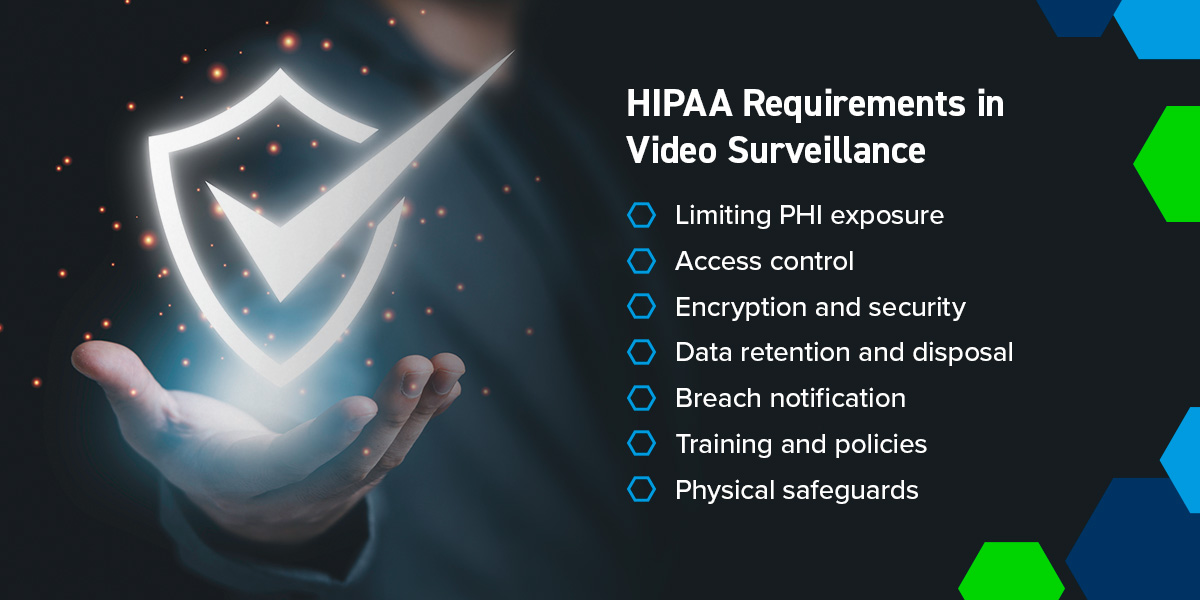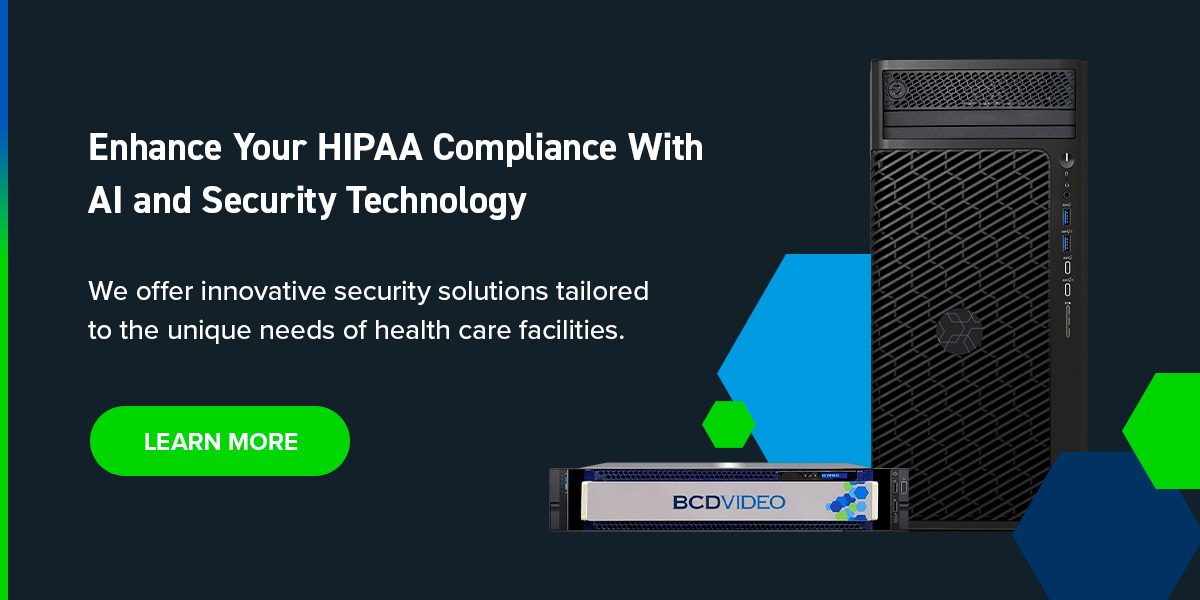Hospitals are turning to video technology to enhance patient care and safety with the rising demand for health care services and the ongoing battle against staffing shortages. However, hospitals looking to expand their video technology must ensure their security program systems are compliant with the Health Insurance Portability and Accountability Act (HIPPA).
Being HIPAA compliant helps protect patient privacy and safeguard sensitive health information. This is non-negotiable in today’s digital age. With the increasing adoption of health care video analytics and artificial intelligence (AI) technology, it’s more crucial than ever to strike the right balance between leveraging technology and maintaining HIPAA compliance.
This article explores how you can establish a HIPAA-compliant video surveillance system for your health care facility.
HIPAA Compliance in Video Surveillance
HIPAA extends beyond paperwork and digital records — its regulations include video surveillance and electronically protected health information (ePHI) in health care settings.
While HIPAA does not specifically address video surveillance, its requirements for privacy and security of PHI affect how it should be implemented. This means anything that could identify a patient, whether their name, medical history or face in a video, falls under HIPAA’s watchful gaze.
Now, when you’re thinking about bolstering your hospital’s video technology, ensuring that your video surveillance systems play by HIPAA’s rules is essential. This involves verifying that your cameras, auido recording devices and any healthcare surveillance video analytics tools you might use are all HIPAA-compliant.
Video analytics in health care systems must be set up in a way that protects patient privacy at every turn. Some ways include encrypting recorded footage, restricting access to authorized personnel or blurring out identifying features.
HIPAA Requirements in Video Surveillance
The following practices help ensure video technology usage complies with HIPAA’s overarching goals:
- Limiting PHI exposure: Place video surveillance in a way that reduces the possibility of collecting PHI unless necessary for a specific, justifiable purpose. Some settings to avoid include places where PHI is likely to be accessible or discussed, such as treatment areas or screen displays.
- Access control: Access to video material should be managed and limited to authorized personnel only. This aligns with HIPAA’s mandate to create technical policies and procedures restricting ePHI access to authorized individuals.
- Encryption and security: Video data should be encrypted in transit and at rest, mainly if it could capture PHI. Encryption keys should protect against unauthorized access, tampering and loss.
- Data retention and disposal: Set up policies for video footage retention and disposal. This security measure ensures it’s kept no longer than necessary and disposed of securely to prevent unauthorized access to PHI.
- Breach notification: If a breach occurs, then facilities must reference the HIPAA Breach Notification Rule. This rule requires you to notify affected individuals, the Department of Health and Human Services (HHS) and, in some cases, the media.
- Training and policies: Staff should be trained on proper video surveillance system usage. Additionally, you should set up policies regarding using, accessing and monitoring video surveillance to protect PHI.
- Physical safeguards: Camera placement and the physical security of the video surveillance system should be considered to prevent unauthorized viewing or tampering.
8 Best Practices for Adopting Video Analytics
Beyond the foundational HIPAA considerations, there are additional best practices to consider. With these concerns in mind, hospital administrators can improve compliance, protect patient privacy and use video surveillance technology effectively and ethically.
1. Vendor Agreements
If a third-party provider offers or manages the video surveillance system, a Business Associate Agreement (BAA) is required. This agreement assures that the vendor follows HIPAA requirements for protecting and handling PHI.
2. Regular Audits and Assessments
Conduct security risk assessments and audits of the system to identify vulnerabilities and assess compliance with HIPAA regulations. These audits should include reviewing who has accessed video data, and ensuring access controls function as intended. It should also involve verifying that physical and technical safeguards are adequate.
3. Incident Response Plan
Develop and implement an incident response plan. Ensure your response plan includes procedures for responding to security incidents that may affect the confidentiality, integrity or availability of video data containing ePHI. This plan should also outline steps for mitigating risks, documenting incidents and reporting breaches in compliance with HIPAA requirements.
4. Notice of Privacy Practices
Ensure your Notice of Privacy Practices (NPP) reflects the potential for video recording in areas where patients are treated or where PHI may be disclosed. Patients should be informed about how their information — including video recordings — may be used. Patients should also be aware of their rights regarding those recordings.
5. Consent and Signage
In some cases, it may be necessary or required to acquire explicit consent from patients or to display signage informing them of video surveillance. This depends on state regulations and the specific contexts in which video surveillance is used in health care facilities.
6. State Laws and Regulations
Be aware of and comply with state-specific laws and regulations regarding video surveillance in health care settings. Some states may have more stringent requirements than HIPAA regarding patient consent, the use of video recordings or privacy protections.
7. Integration With Other Security Measures
Ensure that video surveillance is integrated into the broader security and privacy framework. This approach includes aligning video surveillance practices with other physical and technical safeguards to protect PHI. These safeguards have secure communication channels, data encryption and access control systems.
8. Training and Awareness
Provide ongoing training and awareness programs for staff about the proper usage of video surveillance systems. These trainings can include the importance of protecting patient privacy, and the legal requirements surrounding PHI.
AI and HIPAA Compliance in Health Care
Technology continuously evolves and we’ve seen increasing usage of artificial intelligence (AI). But how is AI used in health care? How is it used for video surveillance in health care settings?
Imagine having a virtual assistant that constantly watches over your video footage, analyzing it in real-time to flag any potential HIPAA violations. That’s where AI-driven analytics come in. These algorithms can automatically detect and redact sensitive information from your surveillance footage. This helps ensure that only authorized personnel can access it.
But AI doesn’t stop there.
With AI-powered remote monitoring solutions, you can monitor your surveillance cameras anywhere, anytime, from your device. These AI solutions help streamline surveillance operations and allow you to respond quickly to incidents or security breaches.
See AI as giving your health care facility’s security system a high-tech upgrade that can help automate compliance tasks, improve data security and streamline surveillance operations.
Enhance Your HIPAA Compliance With AI and Security Technology
Health care facilities can comply with HIPAA requirements with video analytics and AI-driven solutions while streamlining their surveillance operations. If you’re considering upgrading your facility’s video camera technology, partner with BCD.
We offer innovative security solutions tailored to the unique needs of health care facilities. Our solutions boast features like NDAA compliance, cyber-hardened hardware and validated integration with top VMS and analytics solutions.
By exploring and adopting BCD’s solutions, hospital admins can enhance patient care, improve operational efficiency and build a safer, smarter health care environment.
So, why wait? Contact us online for further information.



